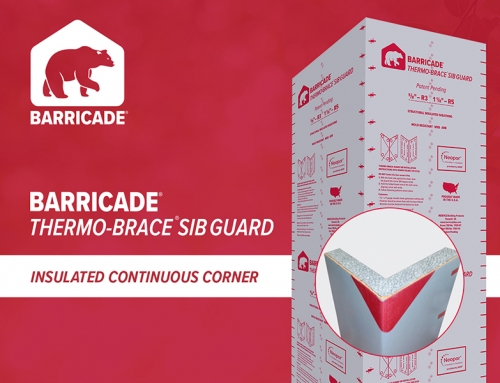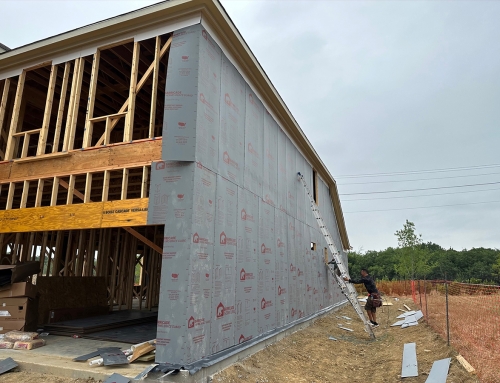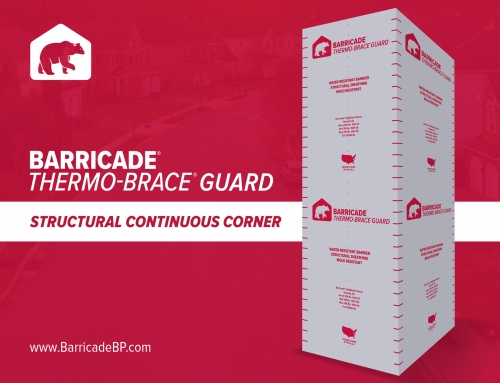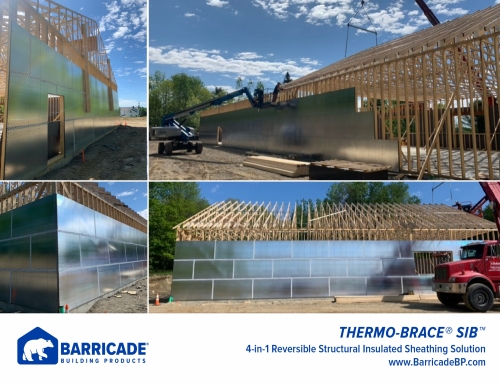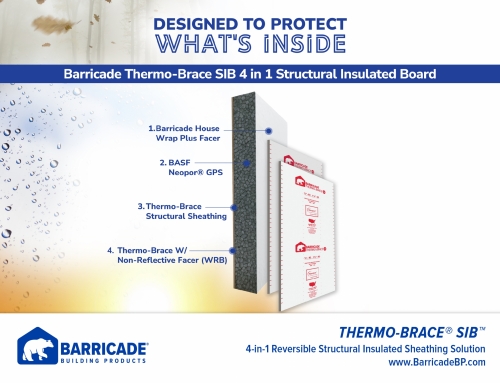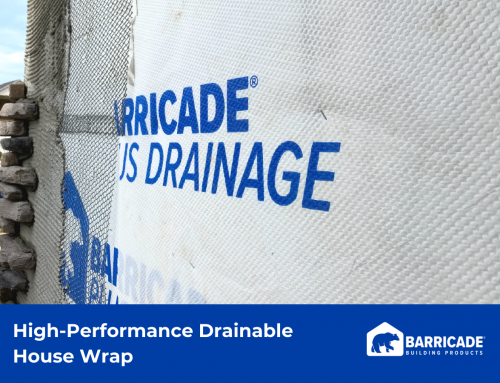Energy-efficient buildings with airtight envelopes need high-performing moisture barrier systems, like Barricade Thermo-Brace®. A high-performing moisture barrier system is air- and water-resistant and vapor permeable. Vapor permeability is vital to preventing water accumulation in the wall system, which can cause mold and rot.
Thermo-Brace is a high-performing moisture barrier system that is air-and water-resistant and vapor permeable. Application of Thermo-Brace ensures an energy-efficient, healthy, and durable building.
Energy-Efficient Buildings Require High-Performing Moisture Barrier Systems
Modern energy-efficient construction, with continuous insulation and high thermal resistance, has escalated the need for high-performance moisture barrier systems. A high-performance moisture barrier system is air-and water-resistant and vapor permeable. It protects a wall system from liquid and vapor infiltration and accumulation.
Controlling moisture accumulation within the tight building envelope of an energy-efficient wall system is essential to the integrity of the structure and the health of its occupants. A high-performance moisture barrier system is necessary towards ensuring that today’s energy efficient buildings are also healthy and durable.
What is Continuous Insulation?
Continuous insulation (CI) in exterior walls is vital and a required design element of energy efficient and high performing buildings. The ASHRAE Standard 90.1-2013 defines continuous insulation as insulation that is uncompressed and continuous across all structural members without thermal bridges other than fasteners and service openings.
Installation of CI is on the exterior, interior, or any opaque surface1 of the building’s envelope. Wrapping a building’s envelope, including the exterior walls, with a layer of CI increases the effective R-value of an energy-efficient building.
What is High Thermal Resistance?
A material with high thermal resistance and low thermal conductivity, like Thermo-Brace, is a good quality insulator because it inhibits thermal conduction.2 Thermal conduction is when warm molecules spontaneously move towards and collide with colder molecules. For instance, in the summer, heat from the outside will gravitate towards the cool interior wall system of a building.
The ability of a material (like insulation) to resist heat flow (conduction) is its thermal resistance. Plastics, polystyrene foam, and Thermo-Brace are examples of good insulators with high thermal resistance and low thermal conductivity.
A High-Performing Moisture Barrier System is Air-Resistant
Air-resistance that limits thermal convection3 is an essential feature of a high-performing moisture barrier. Thermal convection occurs with warm air (which contains moisture) outside the wall system, is drawn to the cooler air within the wall system. Air transporting moisture to the interior of a wall system is a problem because when the vapor comes in contact with the cooler interior walls, the vapor turns to liquid by condensation4.
A successful air barrier limits air flow, and the moisture associated with it, to the interior wall system and the consequential moisture build-up due to condensation.
A High-Performing Moisture Barrier System is Permeable
The permeability of a high-performing moisture barrier ensures evaporation of the moisture within the wall system. Permeability (as measured by perm) is a wall assembly’s ability to drain and dry the moisture in at least one direction; however, two directions are best.
Water can intrude a wall system in many ways: when rain leaks through the building envelope, through convection and conduction, and from the inside of the building if the HVAC system does not adequately remove the moisture. Therefore, moisture vapor permeability of an airtight, energy-efficient wall assembly is vital so the moisture can escape and not get trapped in the wall system.
Creating a Durable and Healthy Building with a High-Performing Moisture Barrier System
A high-performing moisture barrier creates a durable and healthy building. A high-performing moisture barrier provides moisture management of a building’s envelope and is critical to preventing rot and mold growth. Rot degrades a building and mold is unhealthy to the occupants of the structure.
A high-performing moisture barrier is permeable and allows moisture within the wall system to diffuse, which ensures the integrity and indoor environmental quality of the building.
Barricade Thermo-Brace — a Superior High-Performing Moisture Barrier System

Barricade Thermo-Brace is a structural sheathing that is also a high-performing moisture barrier system. Thermo-Brace preserves the integrity of the wall system and creates a tight building envelope. The tight building envelope protects the wall system from air and water infiltration and contributes towards continuous insulation.
In fact, all grades of Thermo-Brace are evaluated and permitted as water-resistive barriers (WRBs) noted in the 2018 International Residential Code (IRC) for water resistance (IRC R703.1.1) and the 2018 International Building Codes (IBC 1402.2) requirements of a WRB for water-resistance and vapor permeability.
Energy-efficient structures with tight building envelopes require a high-performance moisture barrier system, like Thermo-Brace. The moisture barrier must be air- and water-resistant and vapor permeable, so that water doesn’t accumulate in the wall system. Controlling moisture accumulation within the wall system is critical to the durability of the structure and the health of the occupants.
A high-performing moisture barrier system is air-and water-resistant and vapor permeable and is crucial towards achieving healthy and energy-efficient buildings.
1Opaque areas are all areas of the building envelope except openings for doors, windows, skylights, and building service systems. For example, although solid metal and wood doors are opaque, they are not included as part of the opaque wall area.
2Thermal conduction is when warm molecules spontaneously move towards and collide with cooler molecules. The effective R-value of a home’s wall assembly is its resistance to conduction (the movement of hot molecules towards cooler molecules).
3Thermal convection is the transfer of heat energy from a hotter place to a cooler place by the movement of fluids (usually liquids and gases). For instance, if it is warmer inside a building, then it is outside the building, the hotter air will move towards the cooler air. Minimizing air infiltration (hot air flowing towards cooler air) is important for limiting the loss of heat energy inside the building.
4Condensation is when water vapor (in the air) changes into liquid water. Condensation occurs when the temperature hits the dew point. The dew point temperature is when the air becomes saturated with water vapor. Under the dew point, the vapor turns to liquid water. Moreover, when the air temperature drops below its dew point through contact with a colder space (like a wall system) water will condense on the space.


